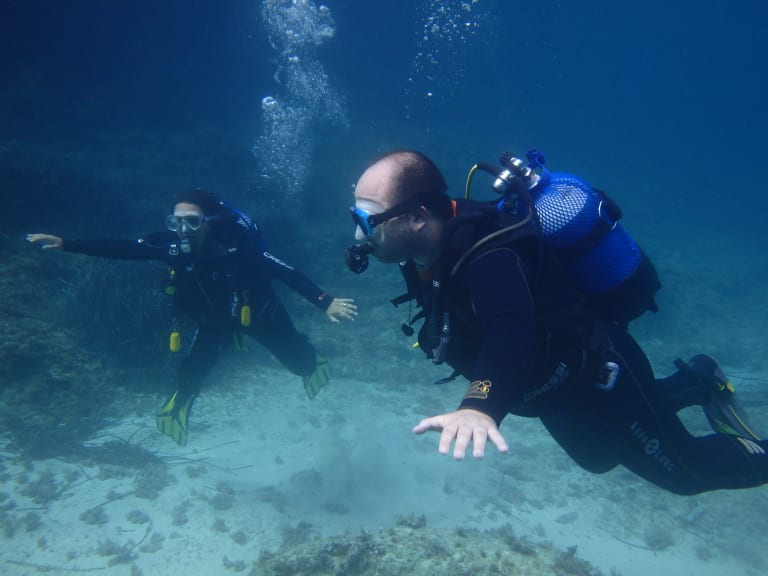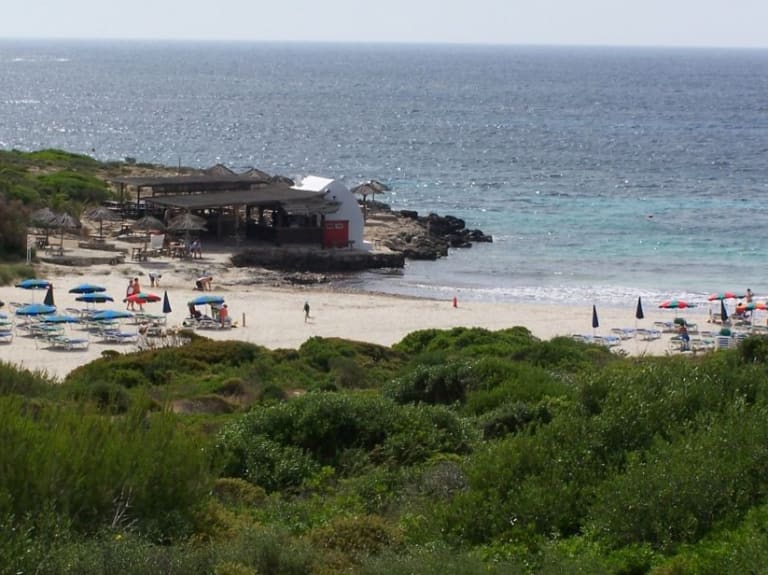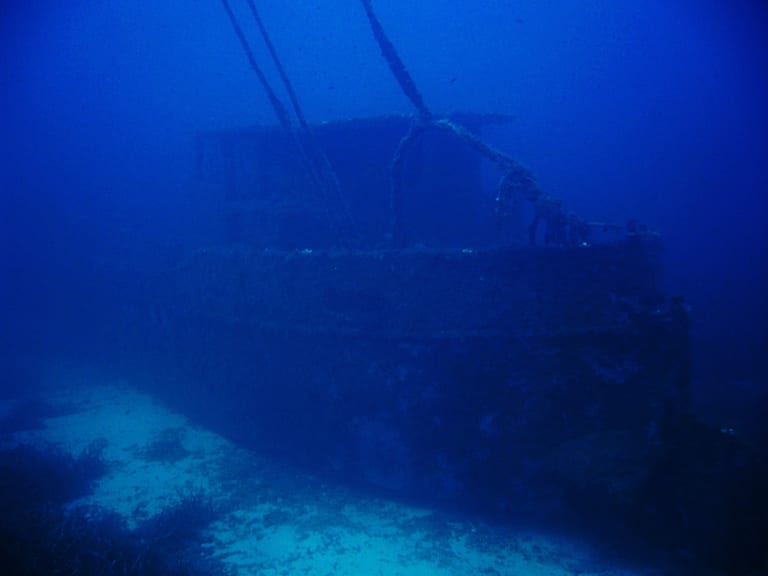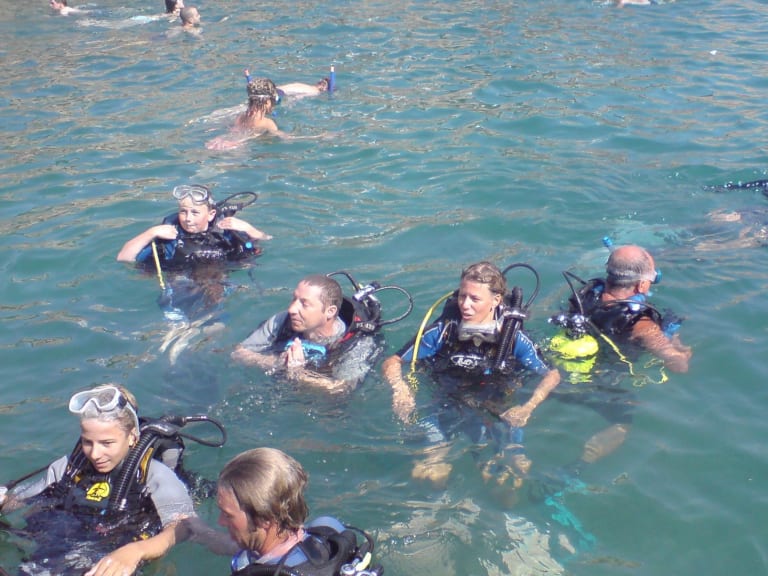More about: Diving in Menorca
With its warm, crystal clear waters, the island of Menorca is a diving paradise. Its underwater world has plenty to explore, from incredible reefs and underwater caves to historic shipwrecks. Moreover, wherever you dive, you will be able to delight in the regional underwater fauna, especially in the Marine Reserve area.
There is so much to see and do in Menorca, if you don't know where to start, don't worry, in this article I will tell you everything you need to know to live a unique diving experience in Menorca. Are you ready? Let's dive!
1. Diving baptism

The baptism of diving, as its name suggests, is the first approach to this activity by people who have never done it before.
It should be clarified that anyone from 8 or 10 years of age can do this baptism, as you will always dive under the guidance of a professional instructor, so there is no risk.
In this type of activity you will first receive a short theory class, where the instructor will explain the basic and main fundamentals of diving.
Then there is usually a small practice in a shallow area or in a swimming pool, and then the experience itself, where you dive, reaching a depth of between 5 and 10 metres at the most. The total duration is two hours.
You can opt for an individual baptism, although in general the instructors take few students, because the safety of the activity is guaranteed.
Another option is to take a family diving baptism. An unforgettable experience where everyone can have an incredible time together.
2. Dive in the marine reserve of Menorca

There are institutions specialised in responsible tourism that take you diving in the Marine Reserve in a way that respects the environment, without disturbing the fauna of the area and intervening as little as possible with the environment, in order to preserve it as much as possible.
One of these options is Diving Menorca. There they offer alternatives for beginners, as well as diving courses and dives for the more advanced divers.
Located in the north of the island, this area was declared a "reserve" in 1999, for the conservation of the species that inhabit it.
You will see that, in the Marine Reserve of Menorca, fishing is prohibited, and thanks to this the marine fauna has grown a lot over time, giving rise to one of the most beautiful underwater landscapes you can imagine.
Its waters include the area from Cap Gros and Illa des Porros to Punta des Morter.
Diving and snorkelling enthusiasts can enjoy an authentic underwater safari, contemplating in their natural habitat marine species as diverse as octopus, moray eels, groupers, red lobsters, red mullet and other species typical of the waters of the Mediterranean Sea.
3. Learn to dive in Menorca

If you are interested in diving but have never done it before, Menorca is the ideal place to live an initiation experience. There are several options on the island, but without a doubt the underwater training centre S'Algar Diving is one of the most popular with young people who come to Menorca. That's why you'll notice a youthful atmosphere in the surrounding area, and you'll even find a beach club very close by, where young people tend to get together and enjoy themselves.
S'Algar Diving offers numerous maritime experiences, among which scuba diving is one of the most popular.
The centre has a huge practice pool, as well as the corresponding boats and equipment to provide a complete experience in the open sea.
They have the option of taking the theoretical part of the diving classes online, on their e-learning platform. This alternative is ideal for those who want to optimise the time of their stay, being able to take the course even before their holidays, so that once in Menorca they can enjoy the experience instead of taking classes in a classroom.
The S'Algar Diving centre also offers trips to the Marine Reserve, boat trips and snorkelling in Menorca.
If you already have some previous experience and are looking to go deeper, there are many options to polish your underwater skills in Menorca. At sites like Diving Menorca or Scuba Plus, for example, you can sign up for an advanced diving course.
As with the baptism, you will have a theoretical and a practical part. In the theory classes you will learn how to use diving equipment correctly, ways to communicate underwater, as well as about the effects of underwater pressure on the body and methods to compensate for it, and much more.
The practical sessions are always supervised by professional instructors who are on hand to solve any problems that may arise, answer any questions you may have and look after your safety.
After taking a final exam you will obtain your certificate, which (according to the course you have taken) will entitle you to dive anywhere in the world.
4. Dive in Catedral, know the biggest cave of Cap d'en Font

Do one of the most popular dives on the north coast of Menorca, La Catedral.
Entering from Cala Morell, and after crossing a sandy area, if you dive in a westerly direction you will come across the mythical Cova des Coloms, better known as La Catedral, the largest cave in the region.
This is an ideal place for diving, since here you can come across marine species such as langoustines, groupers, lobsters, lobsters, moray eels and scorpion fish.
You can choose to rent the equipment and do the experience on your own if you already have some experience, otherwise you can hire a guided excursion from Binibeca Diving.
There is a curious history behind this cave. Millions of years ago, Menorca had an underground route of rivers that flowed through it forming tunnels. The waters of the river that flowed through these paths, flowed into the sea through a large cave, and that cave could be the one we all know today as the Cathedral of Menorca.
The cave itself is about 24 metres high, another 15 metres wide and about 110 metres in total length. The cathedral ends at what is known as the altar. In addition, this cave has an air chamber, from where the entrance to the cavern can be observed.
To round off this adventure, I recommend that you end your day at Binigaus Beach. A great place to rest after visiting the Cathedral. It is a beautiful and peaceful beach paradise.
5. Diving in the privileged area of Sant Lluís

One of the most amazing spots for diving in Menorca is the Sant Lluís area, in the southern portion of the island. This region has a large number of beaches and coves with unreal turquoise warm waters.
Among the most outstanding are Binibèquer (Binibeca), Binidali, Punta Prima and Binisafua, all of which have crystal clear waters and soft, fine, white sand.
In Sant Lluís you can visit the Isla del Aire which, as well as being popular for having the highest lighthouse in the whole of Menorca, is an ideal area for diving, as it is suitable for all levels. Apart from being able to dive on your own, there are different guided options that start at approximately €38.
The region known as Cagaires offers a majestic scenery of coral reefs with the most amazing colours. Diving in its galleries you can come across fish such as grouper, moray eel, oblada, and conger eel, among others.
And to round off your magnificent underwater experience, you can enjoy a tour of Binibeca Vell, a welcoming and picturesque village of little white houses. Get your camera ready, because you won't be able to stop taking pictures here. The place is truly beautiful, with a Greek island feel.
You can consult the diving school S'Algar diving Menorca, which offers many options in this part of the island.
6. Experience the dive El caracol in Cala Torret

Cala Torret is a small, but grandiose cove in the south of Menorca. It belongs to Sant Lluís and is easily accessible by land. Its quay is always dotted with boats, some of them belonging to companies that offer guided tours.
This area has crystal-clear waters and majestic views, making it a privileged place for water activities such as kayaking and, of course, scuba diving.
The star of this site is the dive known as El Caracol. Here you will find a natural reef full of tunnels, arches and caves where an enormous number of marine species coexist.
El Caracol is a dive suitable for the whole family and for divers of all levels, with a maximum depth of just 21 metres. This reef is located one kilometre from the coast, so you can reach it in a matter of minutes.
7. History underwater

Throughout history, Menorca has been the scene of numerous battles and confrontations between different civilisations, many of them disputing its possession. Witnesses of these events can still be found underwater.
There are many remains of sunken ships that lie scattered in the depths of the southern part of the island.
In this case, the experience is for more experienced divers, as the wrecks lie at great depths. The advantage of the region is that the clear waters of Menorca offer great visibility to enjoy these underwater treasures.
Some of the wrecks that can be seen are the Ocean Diver, submerged at a depth of 27 metres near the beach of San Bou, the Santa Clara, at 47 metres below the surface and off the point of S'Algar, the Francisquita, at a depth of 50 metres off Punta Nati, the Junker-88 aircraft from the Second World War, and the Malakoff, at a depth of 34 metres off Cala Galdana, of which almost nothing remains of what was once a large French cargo ship.
8. More Menorcan caves

In addition to the cave, the Catedral de Cap d'en Font, Menorca has other attractive underwater caves for the delight of diving enthusiasts. One of them is the Pou de sa Lluna. This consists of a large cavern that continues in a rocky corridor. It ends in a circular tunnel-like wall that goes upwards and crosses a halocline. The route ends in an air chamber.
Another peculiar cave in the waters of the island of Menorca is El Campanar. This cave, also located in Cap d'en Font, stands out for its great beauty. This is an exclusive experience for experienced divers.
The main entrance is at a depth of 18 metres and inside you can see large columns and an air chamber with amazing stalactites in it.
9. Explore the depths in Cala Galdana

This is one of the many beaches in Minorca that has a wide variety of services for tourists, and diving is one of them. At the same time, Cala Galdana is one of the best beaches in Minorca for families, thanks to the fact that it has all the necessary services to spend the day, guaranteeing a comfortable stay.
Another great advantage of this beach is that it is very accessible by land, whether you have your own car or you want to go by public transport.
Cala Galdana, or Santa Galdana as it is officially called, is located in Ferreries and is a popular seaside resort. It is a circular bay of fine sand and crystal clear water, like most of the beaches on the island, and therefore offers perfect conditions for scuba diving and boat trips.
The underwater dives in this cove involve a very low difficulty, so the activity is suitable for all levels of divers, of all ages. There are not many currents in the area and the maximum depth that can be reached when diving in Cala Galdana is 15 metres.
Among the main attractions you can see here is the famous Barbada Cala Galdana, which consists of an underwater wall of about 15 metres, running from north to south. Its surface is covered with holes, which makes it even more striking.
Another interesting attraction in Cala Galdana is the Malakoff, which I mentioned above. This old cargo ship of about 7000 tons, after its sinking in 1959, created a reef that today is home to hundreds of underwater species. You can dive this cove with dive centres such as Blue island diving.
10. Go through the chimney

An interesting dive site, but only suitable for professional or experienced divers, is the dive known as the Chimney.
This important cenote is located at Codolada Point, at the northern end of Punta Grossa. The tour to get to know this natural attraction begins by advancing along the wall, at about 25 metres, which then drops in a steep slope from 32 metres.
This creates the sensation of falling into the void, and you can reach a depth of 40 metres at this point.
Then, after about 200 metres at anchor, you reach the entrance to a narrow tunnel that leads to the famous chimney. This tunnel is so narrow that it allows only one diver at a time to pass through.
In this part of the route, you will come across underwater species such as crabs, crayfish, shrimps and porcelain shrimps. The chimney itself is in the form of a circular tunnel of approximately 3 metres in diameter, which rises vertically until it reaches the surface of the cliff.
On the way to the surface you can see the beautiful light of the sun's rays. On days when the sea is rough, the chimney spouts water like a geyser.













